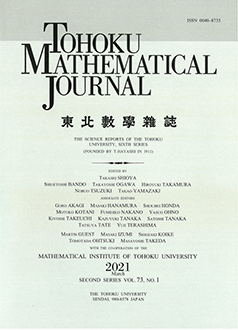Abstract
Let $x:\M^m\to \hs^n$ be a submanifold in the $n$-dimensional sphere $\hs^n$ without umbilics. Two basic invariants of $x$ under the Möbius transformation group in $\hs^n$ are a 1-form $\F$ called the Möbius form and a symmetric $(0,2)$ tensor $\bf A$ called the Blaschke tensor. $x$ is said to be Möbius isotropic in $\hs^n$ if $\F\equiv 0$ and ${\bf A}=\l dx\cdot dx$ for some smooth function $\l$. An interesting property for a Möbius isotropic submanifold is that its conformal Gauss map is harmonic. The main result in this paper is the classification of Möbius isotropic submanifolds in $\hs^n$. We show that (i) if $\l >0$, then $x$ is Möbius equivalent to a minimal submanifold with constant scalar curvature in $\hs^n$; (ii) if $\l=0$, then $x$ is Möbius equivalent to the pre-image of a stereographic projection of a minimal submanifold with constant scalar curvature in the $n$-dimensional Euclidean space $\R^n$; (iii) if $\l <0$, then $x$ is Möbius equivalent to the image of the standard conformal map $\t: \text{\bi H}^n\to \hs^n_+$ of a minimal submanifold with constant scalar curvature in the $n$-dimensional hyperbolic space $\text{\bi H}^n$. This result shows that one can use Möbius differential geometry to unify the three different classes of minimal submanifolds with constant scalar curvature in $\hs^n$, $\R^n$ and $\text{\bi H}^n$.
Citation
Huili Liu. Changping Wang. Guosong Zhao. "Möbius isotropic submanifolds in {$S\sp n$}." Tohoku Math. J. (2) 53 (4) 553 - 569, 2001. https://doi.org/10.2748/tmj/1113247800
Information





